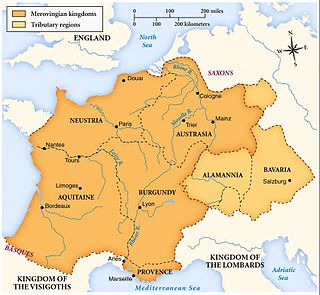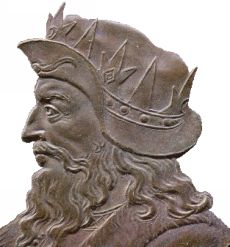Related Research Articles

The Burgundians were an early Germanic tribe or group of tribes. They appeared in the middle Rhine region, near the Roman Empire, and were later moved into the empire, in eastern Gaul. They were possibly mentioned much earlier in the time of the Roman Empire as living in part of the region of Germania that is now part of Poland.

The Merovingian dynasty was the ruling family of the Franks from around the middle of the 5th century until 751. They first appear as "Kings of the Franks" in the Roman army of northern Gaul. By 509 they had united all the Franks and northern Gallo-Romans under their rule. They conquered most of Gaul, defeating the Visigoths (507) and the Burgundians (534), and also extended their rule into Raetia (537). In Germania, the Alemanni, Bavarii and Saxons accepted their lordship. The Merovingian realm was the largest and most powerful of the states of western Europe following the breaking up of the empire of Theodoric the Great.

Clovis was the first king of the Franks to unite all of the Frankish tribes under one ruler, changing the form of leadership from a group of petty kings to rule by a single king and ensuring that the kingship was passed down to his heirs. He is considered to have been the founder of the Merovingian dynasty, which ruled the Frankish kingdom for the next two centuries. Clovis is important in the historiography of France as "the first king of what would become France".

Flavius Childeric I was a Frankish leader in the northern part of imperial Roman Gaul and a member of the Merovingian dynasty, described as a king, both on his Roman-style seal ring, which was buried with him, and in fragmentary later records of his life. He was father of Flavius Chlodovechus, who acquired effective control over all or most Frankish kingdoms, and a significant part of Roman Gaul.

Gregory of Tours was a Gallo-Roman historian and Bishop of Tours during the Merovingian period and is known as the "father of French history." He was a prelate in the Merovingian kingdom, encompassing Gaul's historic region.

Chlothar I, sometime called "the Old", also anglicised as Clotaire, was a king of the Franks of the Merovingian dynasty and one of the four sons of Clovis I.

The Kingdom of the Franks, also known as the Frankish Kingdom, the Frankish Empire or Francia, was the largest post-Roman barbarian kingdom in Western Europe. It was ruled by the Frankish Merovingian and Carolingian dynasties during the Early Middle Ages. Francia was among the last surviving Germanic kingdoms from the Migration Period era.

Chlodio, also Clodio, Clodius, Clodion, Cloio or Chlogio, was a Frankish king who attacked and then apparently ruled Roman-inhabited lands around Cambrai and Tournai, near the modern border of Belgium and France. He is known from very few records.

The Salian Franks, also called the Salians, were a northwestern subgroup of the early Franks who appear in the historical record in the fourth and fifth centuries. They lived west of the Lower Rhine in what was then the Roman Empire and today the Netherlands and Belgium.

Ripuarian or Rhineland Franks were one of the two main groupings of early Frankish people, and specifically it was the name eventually applied to the tribes who settled in the old Roman territory of the Ubii, with its capital at Cologne on the Rhine river in modern Germany. Their western neighbours were the Salii, or "Salian Franks", who were named already in late Roman records, and settled with imperial permission within the Roman Empire in what is today the southern part of the Netherlands, and Belgium, and later expanded their influence into the northern part of France north of the Loire river, creating the Frankish empire of Francia.
Liber Historiae Francorum is a chronicle written anonymously during the 8th century. The first sections served as a secondary source for early Franks in the time of Marcomer, giving a short breviarum of events until the time of the late Merovingians. The subsequent sections of the chronicle are important primary sources for the contemporaneous history. They provide an account of the Pippinid family in Austrasia before they became the most famous Carolingians.

The Franks were a western European people during the Roman Empire and Early Middle Ages. They began as a Germanic people who lived near the Lower Rhine, on the northern continental frontier of the empire. They subsequently expanded their power and influence during the Middle Ages, until much of the population of western Europe, particularly in or near France, were commonly described as Franks, for example in the context of their joint efforts during the crusades starting in the 11th century. This expansion came about because the romanized Frankish dynasties based within the collapsing Western Roman Empire first became the rulers of the whole region between the rivers Loire and Rhine, and then subsequently imposed power over many other post-Roman kingdoms both inside and outside the old empire.
The First Council of Orléans was convoked by Clovis I, King of the Franks, in 511. Clovis called for this synod four years after his victory over the Visigoths under Alaric II at the Battle of Vouillé in 507. The council was attended by thirty-two bishops, including four metropolitans, from across Gaul, and together they passed thirty-one decrees. The bishops met at Orléans to reform the church and construct a strong relationship between the crown and the Catholic episcopate, the majority of the canons reflecting compromise between these two institutions.

The Lex Burgundionum refers to the law code of the Burgundians, probably issued by king Gundobad. It is influenced by Roman law and deals with domestic laws concerning marriage and inheritance as well as regulating weregild and other penalties. Interaction between Burgundians is treated separately from interaction between Burgundians and Gallo-Romans. The oldest of the 14 surviving manuscripts of the text dates to the 9th century, but the code's institution is ascribed to king Gundobad, with a possible revision by his successor Sigismund. The Lex Romana Burgundionum is a separate code, containing various laws taken from Roman sources, probably intended to apply to the Burgundians' Gallo-Roman subjects. The oldest copy of this text dates to the 7th century.
The pagan religion of the Germanic tribal confederation of the Franks has been traced from its roots in polytheistic Germanic paganism through to the incorporation of Greco-Roman components in the Early Middle Ages. This religion flourished among the Franks until the conversion of the Merovingian king Clovis I to Nicene Christianity, though there were many Frankish Christians before that. After Clovis I, Frankish paganism was gradually replaced by the process of Christianisation, but there were still pagans in the late 7th century.

Germanic law is a scholarly term used to describe a series of commonalities between the various law codes of the early Germanic peoples. These were compared with statements in Tacitus and Caesar as well as with high and late medieval law codes from Germany and Scandinavia. Until the 1950s, these commonalities were held to be the result of a distinct Germanic legal culture. Scholarship since then has questioned this premise and argued that many "Germanic" features instead derive from provincial Roman law. Although most scholars no longer hold that Germanic law was a distinct legal system, some still argue for the retention of the term and for the potential that some aspects of the Leges in particular derive from a Germanic culture.

Christianization of the Franks was the process of converting the pagan Franks to Catholicism during the late 5th century and early 6th century. It was started by Clovis I, regulus of Tournai, with the insistence of his wife, Clotilde and Saint Remigius, the bishop of Reims.

The Franco-Visigothic Wars were a series of wars between the Franks and the Visigoths, but it also involved the Burgundians, the Ostrogoths and the Romans. The most noteworthy war of the conflict would be the Second Franco-Visigothic War that included the famous Battle of Vouillé and resulted in Frankish annexation of most of Southern France.
References
Historians of Merovingian institutions and law wrote of the antrustions, and each has a different system. The principal authorities are:
- Waitz, Deutsche Verfassungsgeschichte, 3rd ed. vol. ii. pp. 335 et seq.
- Brunner, Deutsche Rechtsgeschichte, vol. ii. p. 97 et seq.
- Fustel de Coulanges, La Monarchie franque, p. 80 et seq.
- Maxirne Deloche, La Trustis et Vantrustion royal sous les deux premieres races (Paris, 1873), collecting and discussing the principal texts
- Guilhermoz, Les Origines de la noblesse (Paris, 1902), suggesting a system which is new in part. [5]